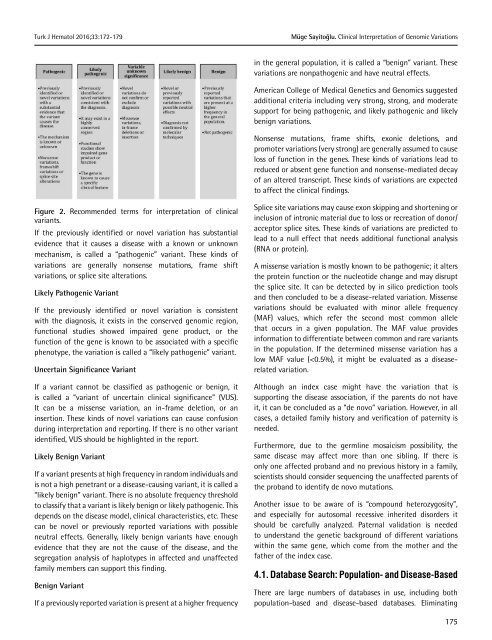Turkish Journal of Hematology Volume: 33 - Issue: 3
You also want an ePaper? Increase the reach of your titles
YUMPU automatically turns print PDFs into web optimized ePapers that Google loves.
Turk J Hematol 2016;<strong>33</strong>:172-179<br />
Müge Sayitoğlu. Clinical Interpretation <strong>of</strong> Genomic Variations<br />
in the general population, it is called a “benign” variant. These<br />
variations are nonpathogenic and have neutral effects.<br />
American College <strong>of</strong> Medical Genetics and Genomics suggested<br />
additional criteria including very strong, strong, and moderate<br />
support for being pathogenic, and likely pathogenic and likely<br />
benign variations.<br />
Nonsense mutations, frame shifts, exonic deletions, and<br />
promoter variations (very strong) are generally assumed to cause<br />
loss <strong>of</strong> function in the genes. These kinds <strong>of</strong> variations lead to<br />
reduced or absent gene function and nonsense-mediated decay<br />
<strong>of</strong> an altered transcript. These kinds <strong>of</strong> variations are expected<br />
to affect the clinical findings.<br />
Figure 2. Recommended terms for interpretation <strong>of</strong> clinical<br />
variants.<br />
If the previously identified or novel variation has substantial<br />
evidence that it causes a disease with a known or unknown<br />
mechanism, is called a “pathogenic” variant. These kinds <strong>of</strong><br />
variations are generally nonsense mutations, frame shift<br />
variations, or splice site alterations.<br />
Likely Pathogenic Variant<br />
If the previously identified or novel variation is consistent<br />
with the diagnosis, it exists in the conserved genomic region,<br />
functional studies showed impaired gene product, or the<br />
function <strong>of</strong> the gene is known to be associated with a specific<br />
phenotype, the variation is called a “likely pathogenic” variant.<br />
Uncertain Significance Variant<br />
If a variant cannot be classified as pathogenic or benign, it<br />
is called a “variant <strong>of</strong> uncertain clinical significance” (VUS).<br />
It can be a missense variation, an in-frame deletion, or an<br />
insertion. These kinds <strong>of</strong> novel variations can cause confusion<br />
during interpretation and reporting. If there is no other variant<br />
identified, VUS should be highlighted in the report.<br />
Likely Benign Variant<br />
If a variant presents at high frequency in random individuals and<br />
is not a high penetrant or a disease-causing variant, it is called a<br />
“likely benign” variant. There is no absolute frequency threshold<br />
to classify that a variant is likely benign or likely pathogenic. This<br />
depends on the disease model, clinical characteristics, etc. These<br />
can be novel or previously reported variations with possible<br />
neutral effects. Generally, likely benign variants have enough<br />
evidence that they are not the cause <strong>of</strong> the disease, and the<br />
segregation analysis <strong>of</strong> haplotypes in affected and unaffected<br />
family members can support this finding.<br />
Benign Variant<br />
If a previously reported variation is present at a higher frequency<br />
Splice site variations may cause exon skipping and shortening or<br />
inclusion <strong>of</strong> intronic material due to loss or recreation <strong>of</strong> donor/<br />
acceptor splice sites. These kinds <strong>of</strong> variations are predicted to<br />
lead to a null effect that needs additional functional analysis<br />
(RNA or protein).<br />
A missense variation is mostly known to be pathogenic; it alters<br />
the protein function or the nucleotide change and may disrupt<br />
the splice site. It can be detected by in silico prediction tools<br />
and then concluded to be a disease-related variation. Missense<br />
variations should be evaluated with minor allele frequency<br />
(MAF) values, which refer the second most common allele<br />
that occurs in a given population. The MAF value provides<br />
information to differentiate between common and rare variants<br />
in the population. If the determined missense variation has a<br />
low MAF value (

















